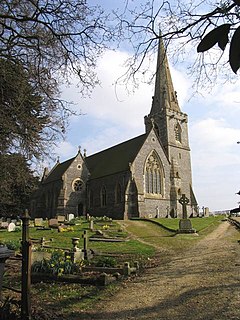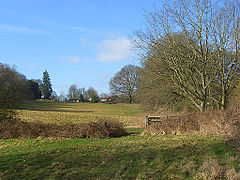Midgham
| Midgham | |
|---|---|
| Villageandcivil parish | |
 St Matthew's parish church was built in 1869 in a tall 13th-century style. | |
 View of upper part of Midgham Park estate. | |
Location withinBerkshire | |
| Area | 5.01 km2(1.93 sq mi) |
| Population | 334 (2011 census)[1] |
| •Density | 67/km2(170/sq mi) |
| OS grid reference | SU5567 |
| Civil parish |
|
| Unitary authority | |
| Ceremonial county | |
| Region | |
| Country | England |
| Sovereign state | United Kingdom |
| Post town | Reading |
| Postcode district | RG7 |
| Dialling code | 0118 |
| Police | Thames Valley |
| Fire | Royal Berkshire |
| Ambulance | South Central |
| UK Parliament | |
| Website | The Midgham Village Website |
Midghamis a village andcivil parishoccupying slopes and theflood plainon the north side of theRiver Kennet,which in summer months draws much of the water from the valley. It has smaller watercourses alongside. It is centred 6 miles (10 km) east ofNewburyand 2 miles (3.2 km) east ofThatcham.The north of theparishis 4.5 miles (7 km) south of theM4 motorway.
Geography
[edit]The village extends from New Road Hill to,Woolhampton Lockin the east, West Berkshire Crematorium in the west, Midgham Marsh (south of theA4 road) in the south and toMidgham Greento the north. Its elevations range from 60 to 121 m (197 to 397 ft) above sea level.[citation needed]
Midgham Wood covers most of the north-west and Channel Wood covers most of the north-east eighth of the parish. The vast majority of the other green space is cultivated land, pasture or hay meadows. The lowland area of lakes, river and canal is greater than that covered by roads across the whole parish, according to the 2005Office for National Statisticssurvey.
History
[edit]Few if anyRomantraces have been found in the parish but there is known to be aRoman Roadwith a river crossing on Midgham Marsh. Midgham was, in the earlymedievalperiod, atownshipin Thatcham parish and is recorded in theDomesday Bookof 1086 as such. A watermill is recorded here valued at 14shillings(£0.70) per year. Giles Pinkney had been granted it byWilliam the ConquerororWilliam II.Pinkney divided it into three sub-manors(this parish sawsubinfeudation): Erley's manor centred on Midgham House plus two unnamed manors, occasionally later named after the families of some of their longest owners 'Chenduit' and 'Everard'. There were three sub-tenants of part, Almær, Ragner and Gilbert in 1086, who held 3virgates,1 virgate and 1hideand 1½ virgates respectively.[2]
The manor continued with the Pinkney Honour, which required "service of ward ofWindsor Castle"including paying £1 for each of its 15manorsacross the region to theconstableof the castle. Robert Pinkney forfeited his estates for rebellion againstKing John,but recovered them on the accession ofHenry III.Midgham's history since theStuart periodis published in national sources and by local historian John Trigg. There is evidence that theKnights Templarsheld land in Midgham but few details are known. Trade tokens have been found from the 17th century near the church so it is certain that there was trade in the area during theearly modern period.When the ecclesiastical parish of Midgham was formed in 1857 the small third manor, Hall Court was converted into thevicarage.[2]
Midgham House
[edit]Poyntz family
[edit]The Poyntz family, ancientlyfeudal barons of Curry MalletinSomerset,later ofIron ActoninGloucestershire,rebuilt Midgham House and lived there from 1735 to 1840.[2]Residents included the diplomat,Stephen Poyntz,and his grandson theMPWilliam Stephen Poyntz.Stephen was governor toPrince William, Duke of Cumberlandwho spent a few years of his youth here; two rooms were added for this, known as the Duke's rooms.[2]It has a 15th-century red-brick former stable block with stone dressing. It is aGrade IIlisted building.[3]
James Johnstone
[edit]In aUniversity College Londonwork of 2012,British Slave Ownership,Midgham House is shown as home of James Johnstone, sole proprietor of theWhitehallestate in 1835. The records state that he was recompensed by thegovernment of the United Kingdomas part of theabolition of slaveryin Britain and her colonies with £5,295 17s 0d (equivalent to £658,721 in 2023 of petty expenditure however as a lump sum of capital far more), for 294 enslaved (claim forJamaicaSt Mary168).[clarification needed]
Benjamin Buck Greene
[edit]Benjamin Buck Greene,who later becameGovernorof theBank of England,purchased the estate in 1856. He had the village chapel, which was near the house and not near the people, demolished in 1868 and the new church completed in the following year.[4]He was followed on his death by Mr A. F. Clarke from 1908 until at least the 1920s.[2]From 1947 until 1955 this country estate was owned by theEarl of Clarendon.
Church
[edit]Midgham had its own chapel from at least 1309. The Chapel of Saint Margaret stood a little to the north-east of the present building (see above section). Midgham was part of the parish of Thatcham until 1857 when Greene, the new squire andlord of the manor,appointed the firstvicar(Rev. John Errington) for the proposedChurch of England parish churchdedicated toSaint Matthew.13th-century in style, the church was built by the architectJohn Johnson.The bell tower hasan embattled parapetand an octagonal stone spire. There is apealof six bells the oldest of which is inscribed "Ellis and Henry Knight made mee 1674." The old chapel stood to the north-east of the present building in the grounds of Midgham House. The registers begin in 1622. The church is part of a six-parishbenefice.[5]
Transport
[edit]To avoid possible confusion withWolverhampton,the station inWoolhampton100 m (330 ft) east of the area's bounds (which is therefore the nearest station to all but the far western borders of Midgham), was renamedMidghamin 1873. This station is a minor stop with regular services on theReading to Taunton Line.[6]
Midgham Lockis on theKennet and Avon Canal.
Amenities
[edit]
The village has a public house, The Coach and Horses. Midgham has a village green which is run by the parish council and a village hall run by its own committee. A variety of trees forms a sort ofarboretumat Midgham Green in the north of the area. The main hall, on the Bath Road, is used for voluntary and social gatherings; its parish council allows it to be hired by fundraisers, lecturers and businesses.
Notable people
[edit]- William Crowe(1745–1829;poetandpublic oratorforOxford University)
- John Jefferys(1701–1754; clockmaker andwatchmaker)
- Sir William Sidney Smith(1764–1840;Royal Navyofficer)
- Benjamin Challenger(1978–present;OlympicAthlete)
Demography
[edit]| Output area | Homes owned outright | Owned with a loan | Socially rented | Privately rented | Other | km2roads | km2water | km2domestic gardens | Usual residents | km2 |
|---|---|---|---|---|---|---|---|---|---|---|
| Civil parish | 49 | 38 | 6 | 23 | 8 | 0.078 | 0.102 | 0.110 | 334 | 5.01 |
References
[edit]- ^abKey Statistics: Dwellings; Quick Statistics: Population Density; Physical Environment: Land Use Survey 2005
- ^abcde"A History of Berkshire"Victoria County HistoryVolume 3, London, 1923. Page and Ditchfield (1923) Retrieved 2014-12-9.
- ^Historic England."Details from listed building database (1319494)".National Heritage List for England.Retrieved9 December2014.
- ^Benjamin Buck Greene at Oxford Dictionary of National Biography
- ^awb.org.ukAldermaston and Woolhampton Benefice –The Church of England.Retrieved 2014-12-9
- ^Butt, R.V.J. (1995).The Directory of Railway Stations.Yeovil: Patrick Stephens Ltd. p. 255.ISBN1-85260-508-1.R508.
Sources
[edit]- Page, William;Ditchfield, P.H.,eds. (1923).Victoria County History:A History of the County of Berkshire, Volume 3.pp. 311–329.
- Pevsner, Nikolaus(1966).The Buildings of England:Berkshire.Harmondsworth:Penguin Books.p. 178.

